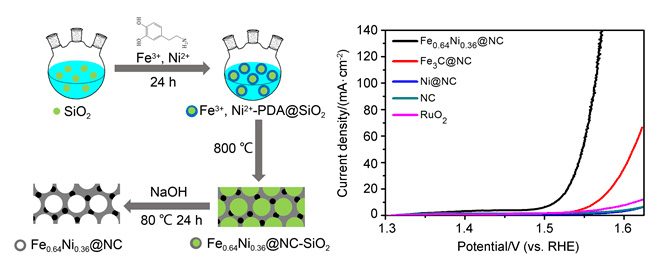摘要/Abstract

非贵金属铁镍合金催化剂在析氧反应(OER)中性能优异,表现出取代贵金属RuO2催化剂的巨大潜力.以SiO2为大孔模板,多巴胺为氮碳源,Fe3+,Ni2+为金属源,通过原位吸附、聚合、焙烧、刻蚀等步骤制备得到铁镍合金纳米颗粒镶嵌的多级孔氮掺杂碳催化剂.碱性介质中的析氧反应测试表明,合金催化剂达到电流密度10 mA·cm-2时过电位仅为286 mV,显著低于以RuO2为催化剂的380 mV过电位;同时经过2000圈循环伏安老化后活性几乎无衰减,稳定性高.所制备的合金催化剂具有两方面结构优势:(1)铁镍合金以及单质铁纳米颗粒镶嵌于大孔碳的薄层孔壁中,有利于暴露活性位点;(2)石墨化氮碳层对合金纳米颗粒的保护提高了材料抗腐蚀性,进而提升其稳定性.
关键词: 多级孔氮掺杂碳, 铁镍合金, 析氧反应
Hydrogen, a clean, efficient and sustainable energy, can be produced via electrochemical water splitting, during which two key processes, hydrogen evolution reaction (HER) and oxygen evolution reaction (OER), occur simultaneously at the two electrodes of an electrolytic cell. Nevertheless compared to the two-electron process of HER, OER, a four-electron process, is of the inherently kinetic hysteresis step, which can dramatically diminish the overall energy conversion efficiency. The highly active noble-metal-based catalyst RuO2 is considered to be one of the most efficient state-of-the-art OER catalysts. However the high cost and element scarcity significantly hinder their practical applications. Thus it is particularly urgent to develop highly-active but low-cost non-noble-metal alternatives. Iron/nickel alloy based catalysts have been widely studied owing to their promising performances. In this work, we prepared iron/nickel alloy nanoparticles embedded in N-doped hierarchically porous carbon (Fe0.64Ni0.36@NC), by simultaneously adsorbing metal precursors and dopamine on surface of SiO2 macroporous hard templates, and then annealing the system and etching the templates. In electrochemical measurements, Fe0.64Ni0.36@NC shows a superior OER activity in alkaline solution, which only needs an overpotential as low as 286 mV to deliver a current density of 10 mA·cm-2, being significantly lower than the value of 380 mV for RuO2. Besides, the catalyst displays no obvious activity decrease after 2000 cycles of continuous CV scanning, corresponding to an excellent durability. The observed nice performances of the alloy catalyst in alkaline solution can be ascribed to two critical structural features:(1) the macroporous structures made by stacking of SiO2 microspheres own relatively thin layer of carbon framework, thus the embedded iron/nickel alloy particles can well activate the surrounding carbon layer to expose copious active sites; (2) the graphitized N-doped carbon layers well protect the alloy nanoparticles from corrosion, thus improving the durability of the catalysts. This work gave a nice design for the highly efficient non-noble-metal OER catalysts.
Key words: N-doped porous carbon, iron/nickel alloys, oxygen evolution reaction
PDF全文下载地址:
点我下载PDF
